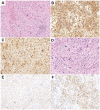Multiple primary malignant neoplasms: A case report and literature review
- PMID: 31579423
- PMCID: PMC6757307
- DOI: 10.3892/ol.2019.10779
Multiple primary malignant neoplasms: A case report and literature review
Abstract
Until recently, few cases of three or more malignant tumors in one patient have been reported. Owing to the high incidence rate of these tumors, the improvement in cancer diagnosis and treatment, and the extension of patient survival time, the incidence of reported multiple primary malignant neoplasms has gradually increased. The present study reported the case of a 57-year-old man with non-small cell lung cancer combined with B-Raf proto-oncogene serine/threonine kinase V600E mutation, gastrointestinal stromal tumors and lumbar vertebral malignant mucinous sarcoma. The pathogenesis, diagnosis and treatment of these three malignancies are discussed and previous studies are also reviewed. The aim of the study was to analyze the genetic mutations associated with multiple primary malignant tumors and to discuss whether those mutations with unknown functional significance could be used as therapeutic indicators. This case report will serve as a reference for future treatment of such patients.
Keywords: BRAF V600E mutation; PD-L1; dabrafenib; gastrointestinal stromal tumor; imatinib; malignant fibromyxoid sarcoma; multiple primary malignant neoplasms; non-small cell lung cancer; trametinib.
Copyright: © Zhang et al.
Figures









References
-
- Mukaiyama Y, Suzuki M, Morikawa T, Mori Y, Takeshima Y, Fujimura T, Fukuhara H, Nakagawa T, Nishimatsu H, Kume H, Homma Y. Multiple primary malignant neoplasms of the glottis, renal pelvis, urinary bladder, oral floor, prostate, and esophagus in a Japanese male patient: A case report. World J Surg Oncol. 2014;12:294. doi: 10.1186/1477-7819-12-294. - DOI - PMC - PubMed
LinkOut - more resources
Full Text Sources
Research Materials
Miscellaneous
